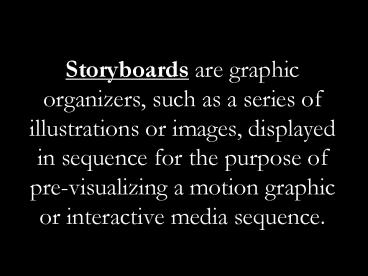Storyboards are graphic organizers, such as a series of illustrations or images, displayed in sequence for the purpose of pre-visualizing a motion graphic or interactive media sequence. - PowerPoint PPT Presentation
1 / 29
Title:
Storyboards are graphic organizers, such as a series of illustrations or images, displayed in sequence for the purpose of pre-visualizing a motion graphic or interactive media sequence.
Description:
Storyboards are graphic organizers, such as a series of illustrations or images, displayed in sequence for the purpose of pre-visualizing a motion graphic or ... – PowerPoint PPT presentation
Number of Views:349
Avg rating:3.0/5.0
Title: Storyboards are graphic organizers, such as a series of illustrations or images, displayed in sequence for the purpose of pre-visualizing a motion graphic or interactive media sequence.
1
Storyboards are graphic organizers, such as a
series of illustrations or images, displayed in
sequence for the purpose of pre-visualizing a
motion graphic or interactive media sequence.
2
- developed at the Walt Disney studio in the early
1930s
One of the first live action films to be
completely storyboarded was Gone with the Wind.
3
- Visual thinking and planning on floor or wall
- -group brainstorming
- -rearranging plot structure i.e. flashbacks
4
Types of Storyboards
5
- Thumbnail Storyboard
- -rough sketches no bigger than your thumbnail
- -basic frames and movements
- -often highest form of storyboards created
6
- Higher quality 2D storyboard images
- -professional storyboard artists
- -2D storyboarding programs. -convey mood of the
scene.
7
- 3D Storyboards
- -show what the film camera will see
- -created using graphic film computer programs
8
- Types of Shots
9
- TIGHTLY FRAMED SHOTS Confined
- LOOSLY FRAMED SHOTS Freedom
10
- Establishing shot (ES)
- -taken from a great distance
- -establishes setting
11
- Wide Shot (WS)
- aka Long Shot
- -shows a scene from a distance (including
characters) - -Stresses the environment or setting of a scene
12
- Medium shot (MS)
- - frames actor(s), normally from the waist up.
- -focus attention on one or two actors (parts
necessary to demonstrate actions or
circumstances)
13
- Over-the-shoulder shot (OS)
- - two characters interacting face-to-face.
- -focuses audience's attention on one actor
- Variation - over the shoulder
- -as if you are directly in the action
14
- Close-up (CU)
- -close range, inches away from actor's face, a
prop, or object. - -focus on facial expression
- -give significance to subject
- -direct audience to an important element of film.
15
- Extreme Close Up (ECU)
- -appeals to one of the audiences five senses
- -achieves an emotional and personal response.
16
- Shot Perspectives
17
- EYE LEVEL SHOTS
- -Audiences sees the event as if in the scene.
- -Clearest view of an object.
- -Treating characters as equals achieves
empathy.
18
- BIRDS EYE VIEW
- -From directly overhead
- -Idea of fate.
19
- HIGH ANGLED SHOTS
- -Camera is tilted downward.
- - Person seems harmless and insignificant
- -being controlled from outside source, fate
20
LOW ANGLED SHOTS -Camera titled upward
-inspires awe -Environment usually
minimized sky or ceiling is
background -Heightens the importance of
a subject
21
- OBLIQUE ANGLE
- -Lateral tilt of the camera.
- -Suggests tensions, transitions, impending
movement - Image that slants to the right Acting forceful
- Image that slants to the left Weak, static
22
Character Perspective Shots
23
- FULL FRONTAL
- -Most intimate, vulnerabilities exposed
- -Relationship between actor and audience
24
- QUARTER TURN high degree of intimacy but with
less emotional involvement
25
PROFILE More remote -Character lost in their
own thoughts.
26
- THREE QUARTER TURN More anonymous.
- Rejecting audiences
27
- BACK TO CAMERA
- -Characters alienation from the world.
- -Sense of concealment, mystery.
28
- What to consider when creating your own
storyboard..
29
- How much, and what, should be included in this
shot? - What is the message and significance of this
shot? - Where should the camera position be angled?































